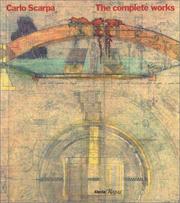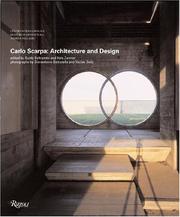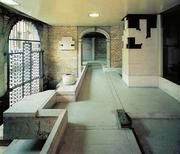| Listing 1 - 10 of 17 | << page >> |
Sort by
|
Book
Abstract | Keywords | Export | Availability | Bookmark
 Loading...
Loading...Choose an application
- Reference Manager
- EndNote
- RefWorks (Direct export to RefWorks)
Carlo Scarpa, Fragments 1926/1978 est un catalogue illustré de l'oeuvre de Carlo Scarpa, trois ans après sa mort. L'ouvrage est en même temps un hommage et peut-être une contribution à une connaissance plus profonde du flux continu de sa recherche
Book
Abstract | Keywords | Export | Availability | Bookmark
 Loading...
Loading...Choose an application
- Reference Manager
- EndNote
- RefWorks (Direct export to RefWorks)
Book
Abstract | Keywords | Export | Availability | Bookmark
 Loading...
Loading...Choose an application
- Reference Manager
- EndNote
- RefWorks (Direct export to RefWorks)
Book
Abstract | Keywords | Export | Availability | Bookmark
 Loading...
Loading...Choose an application
- Reference Manager
- EndNote
- RefWorks (Direct export to RefWorks)
Architecture, Modern --- Albini, Franco --- Scarpa, Carlo, - 1906-1978
Book
ISBN: 9780714848006 071484800X Year: 2013 Publisher: London Phaidon
Abstract | Keywords | Export | Availability | Bookmark
 Loading...
Loading...Choose an application
- Reference Manager
- EndNote
- RefWorks (Direct export to RefWorks)
Carlo Scarpa (1906-1978) is a unique figure in the Modern movement and his work in fact challenged, and continues to challenge, accepted notions of modern architecture. While several books have been published on the subject of Scarpa, the majority narrow in their focus, no comprehensive monograph has been produced to date and certainly not approaching the breadth and depth proposed here by Robert McCarter, who has developed a reputation and following for his meticulously researched, experentially-based, and jargon-free accounts of key figures in Modern architecture. This book will provide the definitive study of Scarpa's many accomplishments, including such works at the Canova Museum, the Castelvechhio Museum, the Brion Cemetery, among others.
Architecture --- Scarpa, Carlo, --- Scarpa, Carlo --- architectuur --- architecture [discipline] --- Scarpa, Carlo, - 1906-1978
Book
ISBN: 8891829129 9788891829122 Year: 2023 Publisher: New York, N.Y. Rizzoli
Abstract | Keywords | Export | Availability | Bookmark
 Loading...
Loading...Choose an application
- Reference Manager
- EndNote
- RefWorks (Direct export to RefWorks)
Carlo Scarpa was one of the great masters of postwar Italian architecture. This book proposes a photographic itinerary that unfurls through Venice, Treviso, Verona and Bologna, before reaching the Dolomites,His most significant projects have been photographed specifically for the book, including constructions and installations in public spaces, such as museums, shops and offices. Each example illustrates Scarpa’s ability to approach the architectural volume as a whole while at the same time tending to its interior layout down to the smallest details, exploring the potential of the material, giving rhythm to the volumes through light, and expressing the poetics of the shape, even in its simplest lines.The projects featured in the book alternate between overviews and close-ups, with a very high photographic quality. They are all briefly introduced by a text that describes their genesis, explains the context in which they were made and focuses on the details that best represent Scarpa’s style, with a summary and clear key to understanding the architect’s work.The volume ends with a postscript by his son, Tobia Scarpa, who is currently designing the forthcoming Scarpa Museum in Treviso.
Architecture, Italian --- 72.07 --- Scarpa, Carlo 1906-1978 (°Venetië, Italië) --- Architectuur ; Italië ; 20ste eeuw ; C.Sarpa --- Italian architecture --- Architecten. Stedenbouwkundigen A - Z --- Scarpa, Carlo, --- Architecture --- Italie --- 20e siècle --- Scarpa, Carlo --- Scarpa, Carlo, - 1906-1978

Abstract | Keywords | Export | Availability | Bookmark
 Loading...
Loading...Choose an application
- Reference Manager
- EndNote
- RefWorks (Direct export to RefWorks)
Architecture --- History --- Histoire --- Scarpa, Carlo, --- architectuur --- Scarpa Carlo --- twintigste eeuw --- Scarpa, Carlo --- Architecture, Modern --- Scarpa, carlo (1906 - 1978)

ISBN: 9780847829118 0847829111 Year: 2023 Publisher: New York, N.Y. Rizzoli
Abstract | Keywords | Export | Availability | Bookmark
 Loading...
Loading...Choose an application
- Reference Manager
- EndNote
- RefWorks (Direct export to RefWorks)
"Carlo Scarpa was a virtuoso of light, a master of detail, and a connoisseur of materials. Today he is known as a master of twentieth-century architecture. To mark the centenary of Scarpa's birth, his complete oeuvre are presented here for the first time. The 250 illustrations cover all 58 of his built works, including the Castelvecchio Museum in Verona, the Olivetti showroom in Piazza San Marco in Venice, and the Brion Tomb in San Vito d'Altivole (Treviso). The book includes essays by leading architects and architectural critics, offering an extensive overview of Scarpa's life as well as interpretations of his architecture."--Jacket.
Scarpa, Carlo, --- Centro internazionale di studi di architettura Andrea palladio --- Architecture --- History --- Criticism and interpretation. --- Scarpa, Carlo --- 72.07 --- Architectuur ; Italië ; 20ste eeuw ; Carlo Scarpa --- Scarpa, Carlo 1906-1978 (°Venetië, Italië) --- Architecten. Stedenbouwkundigen A - Z --- Architecture - Italy - History - 20th century - Catalogs --- Scarpa, Carlo, - 1906-1978 - Catalogs --- Scarpa, Carlo, - 1906-1978

ISBN: 9783930698141 3930698145 Year: 2023 Publisher: Stuttgart Axel Menges
Abstract | Keywords | Export | Availability | Bookmark
 Loading...
Loading...Choose an application
- Reference Manager
- EndNote
- RefWorks (Direct export to RefWorks)
"In recent decades, Carlo Scarpa's relevance has been steadily on the rise. At a time when architects have to use existing city and building structures as a point of departure for their work, his ceuvre remains a source of inspiration. Buildings such as the Castelvecchio in Verona show us that architecture is capable of communicating its own history, has meaning, and develops a contemporary dynamic of its own. Scarpa's layered architecture makes visible the time-related sedimentation of material and meanings. It is especially at points of transition and interface that layering becomes a narrative element that elucidates the tectonic qualities of the building. Overlaying Includes leaving a record of how an object came into being - by means of the sediments of its history or through the intervention of the architect." "In this book Anne-Catrin Schultz presents her research about the phenomenon of layering in Carlo Scarpa's architecture. Layering describes the physical composition of layers defining space as well as the parallel presence of cultural referrals and formal associations imbedded in the physical layers." "Scarpa's work is an embodiment of multidimensional layering and a focal point for architectural movements of his time that have stratification as their theme. In most buildings, the principle of layering may be regarded as something that is part of the nature of building. Functional conditions call for planes, elements, or *layers* to provide the supporting structure, and others to protect from rain, cold or the heat of the sun. However, architectonic layering goes beyond merely fulfilling technical requirements - the principle of layering may be used as a formative method that allows elements of different origins to be combined into a nonhierarchical whole. Layering exists in a realm of complexity and creates references to the world at large." "The first part of the book examines Scarpa's intellectual roots and puts them in perspective with former theories and their interpretation of architecture as layered, for example Gottfried Semper's theory of clothing. The second part displays an analysis of three projects, the Castelvecchio and the Banca Popolare in Verona and the Querini Foundation in Venice."--Jacket.
Book
ISBN: 2870092261 9782870092262 Year: 1985 Publisher: Bruxelles Pierre Mardaga éditeur
Abstract | Keywords | Export | Availability | Bookmark
 Loading...
Loading...Choose an application
- Reference Manager
- EndNote
- RefWorks (Direct export to RefWorks)
Scarpa, Carlo --- Vienne --- 1906-1978 --- Scarpa Carlo --- Carlo Scarpa --- 1906-1978. --- architectuur --- twintigste eeuw --- Italie --- 72.071 --- architectuur 20e eeuw --- architecten --- buitenlandse architecten --- Architecture --- Architecte --- Architecture contemporaine --- Dessin d'architecture --- Ecrit d'architecte --- Aalto, Alvar, --- Le Corbusier --- Wright, Frank Lloyd, --- Venise --- Italy --- Architectural design --- Scarpa, Carlo, --- History --- Histoire --- Le Corbusier, --- Le Corbusier, Charles-Edouard Jeanneret, --- Aalto, Alvar, 1898-1976 --- Le Corbusier, Charles-Edouard Jeanneret, 1887-1965 --- Wright, Frank Lloyd, 1867-1959 --- Scarpa, carlo (1906 - 1978) --- Scarpa, carlo (1906-1978 ) --- Critique et interprétation --- architecture [discipline]
| Listing 1 - 10 of 17 | << page >> |
Sort by
|

 Search
Search Feedback
Feedback About UniCat
About UniCat  Help
Help News
News